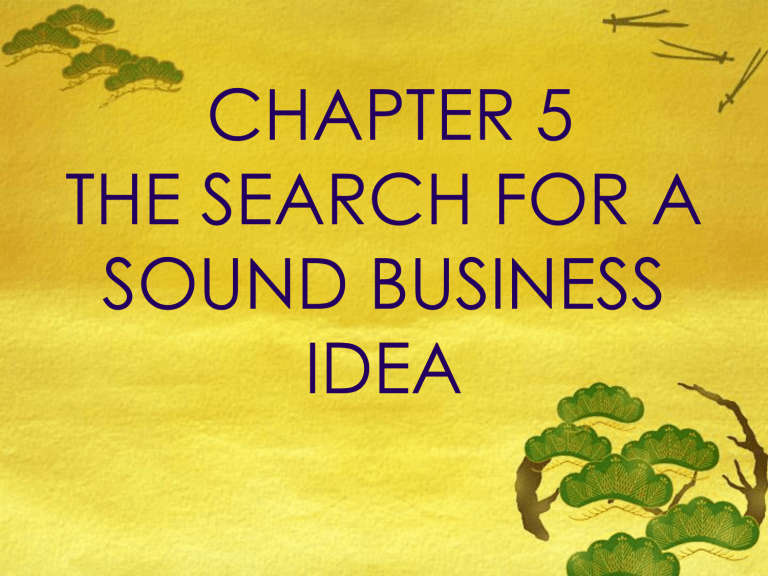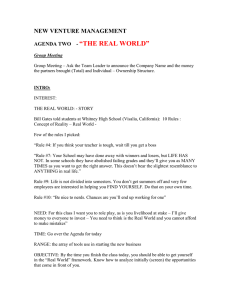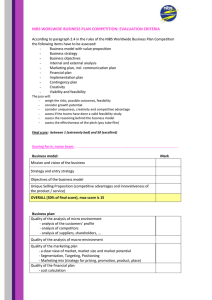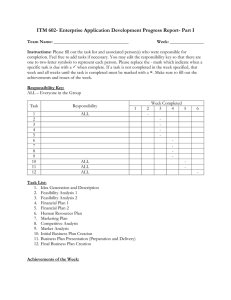
CHAPTER 5 THE SEARCH FOR A SOUND BUSINESS IDEA PRAYER Eternal God, in whom mercy is endless and the treasury of compassion inexhaustible, look kindly upon us and increase your mercy in us, that in difficult moments we might not despair nor become despondent, but with great confidence submit ourselves to Your holy will, which is Love and Mercy itself. Amen. Jesus, we trust in You! If you are going to have a business, what will it be? Write it in our chat box. A new venture is confronted with the immediate concern of gaining at least a foothold in the market it desires to serve. THE PRODUCT OR SERVICE OFFERING MAY BE IMPROVED IN TERMS OF: 1. Performance, like the chair that can carry more weight 2. Maintenance cost, like the car battery that requires less servicing than competing brands THE PRODUCT OR SERVICE OFFERING MAY BE IMPROVED IN TERMS OF: 3. Acquisition cost, like the latest low priced model of a certain brand of cellphone compared to competition. 4. Salvage value, like the steel filing cabinet that has a higher salvage value THE PRODUCT OR SERVICE OFFERING MAY BE IMPROVED IN TERMS OF: 5. Uses, like the flypaper that can also be used as mousetrap. SOUND BUSINESS IDEA may be defined as the economic opportunity which is within the reach of the entrepreneur and which will provide him with a desirable value. BUSINESS IDEAS DIFFER IN FORM 1. An old type of business can be professionalized 2. A standard product can be customized 3. New technology can be adapted to manufacture an old product 4. Imported products can be replaced by local products 5. Business operations can be internationalized. PROCEDURE IN DETERMINING THE BEST BUSINESS IDEA 1. Preparation of the list of business ideas 2. Screening of the listed ideas 3. Final Selection METHODS OF SEARCHING FOR IDEAS 1. Unanticipated means 2. Deliberate search UNANTICIPATED MEANS 1. 2. 3. 4. The person’s work The person’s hobbies The person’s acquaintances A chance event encountered by the person THE PERSON’S WORK Employees who are in direct contact with customers are sometimes confronted with demand for products or services that are not currently provided by the company. THE PERSON’S HOBBIES There are times when a person’s hobby turns out to be a business opportunity. A hobby is a useful means of developing some skill which could be useful later when the hobbyist decides to operate a business. ACQUAINTANCES There are times when a person fails to notice the existence of business opportunity. Sometimes, it takes another person to make him aware of the wisdom of starting a new venture. This other person could be a friend, a neighbor or just anybody he meets once in a while. A CHANCE EVENT There are times when a person encounters an event that will provide him with a clue to a business venture. DELIBERATE SEARCH 1. Using search questions 2. Idea prompting USING SEARCH QUESTIONS 1. How can this product be made differently? 2. What will motivate the consumers to buy my product instead of the competitor’s product? IDEA PROMPTING Encounters with someone else’s idea, or a customer request, or some other event may provide hints or cues leading to business ideas. SCREENING GENERATED IDEAS 1. 2. 3. 4. Market Feasibility Technical Feasibility Financing Feasibility Financial Feasibility MARKET FEASIBILITY 1. Stable and sufficient demand 2. Potential competitive strength of the firm STABLE AND SUFFICIENT DEMAND A business idea will not last if there is insufficient demand for whatever product or service that is contemplated. Demand that remains constant or shows signs of growth throughout long periods indicates the probability of market feasibility. COMPETITIVE STRENGTH The business idea must be such that the venture can effectively compete with current or potential competitors. The competitive strength of the competitors must be determined in terms of product offerings, price, distribution, methods, promotion methods and others. SOURCES OF MARKET INFORMATION 1. Prior studies of the market or related markets by other companies, government agencies, and entrepreneurs. 2. Actual polls of population samples representing typical customers. The means used include the following: mail questionnaires, advertisements incorporating feedback mechanisms such as responses, phone interviews and personal interviews. 3. Negotiations with prospective customers to solicit orders and determine whether or not they will actually buy. TECHNICAL FEASIBILITY Business ideas oftentimes appear easy to execute, but it is not really so when converting them into real products or services with the required quality or quantity. Difficulties may be encountered in the procurement of materials and manpower. FINANCIAL FEASIBILITY 1. The proposed owner’s savings 2. Relatives and friends 3. Financing institutions like banks FINANCIAL FEASIBILITY 1. The preparation of projected financial statements such as income statement, balance sheet statement, and cash flow statement 2. The determination and analysis of financial ratios derived from the projected statements. PROJECTED FINANCIAL STATEMENT The forecast of something which will happen in the future PROJECTED INCOME STATEMENT Is a financial record summarizing a firm’s planned or expected financial performance in terms of revenues, expenses, and profits over a given time period. PROJECTED BALANCE SHEET Shows the planned or expected financial position of the enterprise on a particular date. PROJECTED CASH FLOW STATEMENT Is one which shows the planned or expected cash sale and/or purchases. FINAL SELECTION 1. Status quo 2. A shorter list 3. Zero listing Status quo listing means all business ideas listed passed the adapted criteria. Short list means some of the ideas generated were eliminated. Zero listing means all business ideas generated and listed were eliminated. 1. 2. 3. 4. 5. 6. ORGANIZATIONAL CULTURE AND CREATIVITY Encouragement of creativity and risk-taking Rewards for creativity Open communication Allowance for errors A climate of participation Structural mechanisms that aid creativity ORGANIZATIONAL CULTURE AND CREATIVITY 7. Training in the creative process 8. Flexibility CREATIVITY Refers to activities involved in finding solutions to problems that hinder the achievement of the firm’s objectives. The proactive way of solving problems. OPEN COMMUNICATION The free-flowing exchange of ideas between the members of an organization. Communication flows through the vertical and horizontal relationships in the organization’s structure. FLEXIBILITY One of the distinct characteristics of the creative organization. The creative employee is allowed to engage in creative activities on hours most convenient to him and to the company. REVIEW QUESTIONS AND DISCUSSION 1. 2. 3. 4. What is a sound business idea? Why is it important to the entrepreneur? How may business ideas be generated? What is the disadvantage of unanticipated means of generating business ideas? 5. What is meant by “innovation”? 6. What are the types of innovation? 7. What kind of organizational culture supports innovation? SUGGESTED ITEM FOR RESEARCH List down a business idea which you think has the potential to succeed, if adapted. Why do you think it has the potential to succeed? THANK YOU




